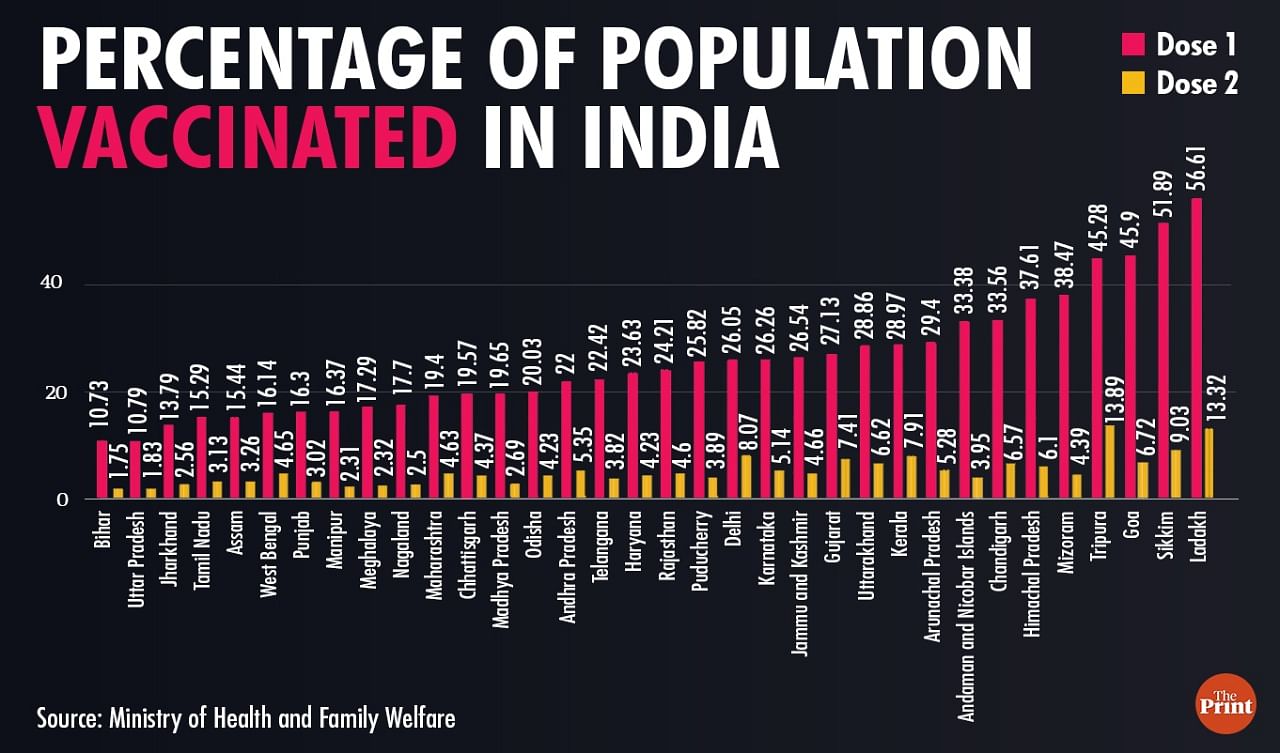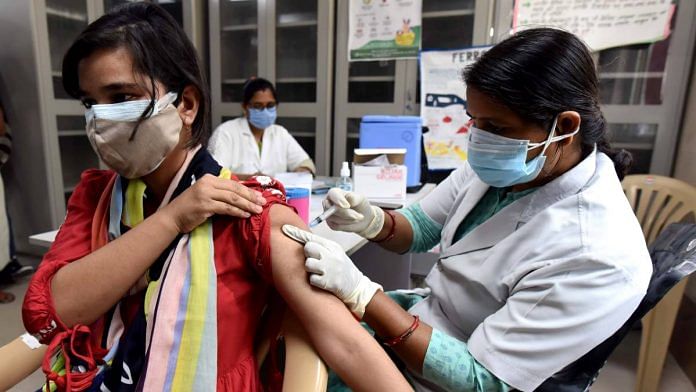New Delhi: India has administered a total of 30,79,48,744 doses of the Covid-19 vaccine as of Thursday, however, states like Bihar, Uttar Pradesh and Jharkhand continue to lag behind in vaccinating their populations.
According to data tabulated by ThePrint, the three states have been the worst performers in terms of the percentage of population that has received at least one dose of the vaccine. The figures are based on the population calculated in the 2011 census.
Bihar occupies the bottom of the table, with only 1,31,27,210 people having received the first dose till Thursday, which accounts for 10.7 per cent of the state’s population. It also has the lowest population of fully-vaccinated individuals — 21,37,362 or 1.74 per cent of the total population.
Uttar Pradesh, India’s most populous state with 22,96,72,000 people, also presents a similar worrying picture. In the state, 2,47,82,239 people have received the first dose of the vaccine, which is also about 10.7 per cent of the state population. Only 1.82 per cent (41,94,231 people) have received the second dose.
Meanwhile, Jharkhand has fully-vaccinated 9,79,456 individuals or 2.5 per cent of its population while 13.7 per cent (52,75,892) have received the first dose.
Tamil Nadu and Assam have also been underperforming in vaccinations; just over 15 per cent of their populations have received the first dose. Furthermore, 3.13 per cent (23,89,511 people) and 3.25 per cent (11,36,046 people) have received both the doses in Tamil Nadu and Assam, respectively.
According to Aritra Das, a consultant epidemiologist at CARE India, a non-governmental organisation, the low coverage of vaccinations in these states makes them vulnerable to Covid waves in the future.
However, he noted that the urban areas in these states do have higher coverage than rural areas and this could offer some protection.
“Since densely populated cities are more likely to be where the disease spreads faster, high vaccine coverage in such areas will also help stop the spread of the disease from urban to rural populations,” Das told ThePrint.
Nevertheless, states with better vaccine coverage will be at an advantage in the coming months, he added.

Also read: Govt readies 2 more testing labs to prepare for new Covid vaccines coming to market
States with highest vaccine coverage
Meanwhile, Ladakh, Sikkim, Tripura, Goa and Mizoram have managed to attain maximum vaccine coverage in the country.
Ladakh and Sikkim are the only two regions where over 50 per cent of the population has received at least one dose of the vaccine. In Ladakh, 1,67,571 people out of a total population of 2,96,000 have received the first vaccine dose while the number stands at 3,49,190 in a population of 6,73,000 in Sikkim.
In Goa, over 45.8 per cent (7,13,714 people) of the population has received at least one dose so far, while Tripura has covered 45.2 per cent (18,34,177) of its population with at least one dose.
As much as 38.4 per cent of the population or 4,65,500 people have received at least the first dose in Mizoram.
However, the share of population that have been fully vaccinated, i.e., received both doses in these states, remains low.
For instance, just over 13 per cent of the population has received both doses of the vaccine in Ladakh.
In Sikkim and Goa, fully-vaccinated individuals account for 9 per cent and 6.7 per cent of the population, respectively.
Dr Anand Krishnan, a professor at AIIMS Centre for Community Medicine, said that this gap in getting the second dose gives an opportunity for new variants of the SARS-CoV-2 virus to emerge.
“However, if you have to optimise the use of the vaccines, some models do suggest that it is more important to get the first dose across the larger population than fully vaccinating the whole population, especially when supply is limited,” Krishnan told ThePrint.
He also pointed out that India needs to focus on distributing vaccines in a consistent and sustainable manner, rather than trying to achieve single-day records.
Referring to the state of Madhya Pradesh, which administered a record-breaking 16.9 lakh vaccine doses Monday, only to plummet to a record low of only 4,563 shots the next day, Krishnan said that states need to manage their resources better.
“This is not a hundred-metre dash where you put all your efforts in a single day, this is a marathon — you have to run for a couple of months now,” he added.
(Edited by Rachel John)
Also read: Why India’s record vaccinations this week may not stop a deadly third wave






